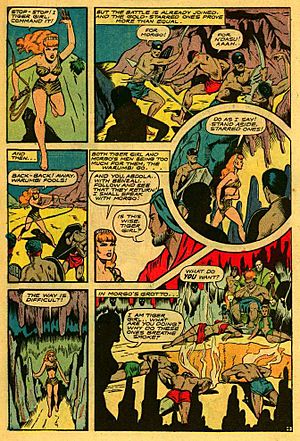Matt Baker (artist) facts for kids
Quick facts for kids Matt Baker |
|
|---|---|

Baker (left) and publisher Archer St. John at Grauman's Chinese Theatre (undated)
|
|
| Born | Clarence Matthew Baker December 10, 1921 Forsyth County, North Carolina |
| Died | August 11, 1959 (aged 37) |
| Nationality | American |
| Area(s) | Penciller |
| Pseudonym(s) | Matt Barkerino |
|
Notable works
|
Phantom Lady |
Clarence Matthew Baker (born December 10, 1921, died August 11, 1959) was a talented American comic book artist. He was famous for drawing strong female heroes like Phantom Lady. He also drew many popular romance comics.
Matt Baker worked during the "Golden Age" of comic books (1940s-1950s). He was one of the first African-American artists to become successful in the comic world. In 2009, Matt Baker was honored in the Will Eisner Comic Book Hall of Fame. Many artists today, like Dave Stevens and Adam Hughes, were inspired by his unique style.
Contents
Meet Matt Baker: A Comic Art Legend
Early Life and Art Journey
Matt Baker was born on December 10, 1921, in Forsyth County, North Carolina. When he was young, his family moved to Pittsburgh, Pennsylvania. After finishing high school in 1940, he moved to Washington, D.C.
During World War II, Matt could not join the military because of a heart condition. Instead, he began studying art at Cooper Union in New York City. He started his career in comics at the Jerry Iger Studio. This studio created comics for publishers who were new to the industry.
Jerry Iger remembered that Matt came to his studio with just one color sketch. He thought the woman in the drawing was so beautiful that he hired Matt right away. Matt started as a background artist. His first confirmed work was drawing women in a "Sheena, Queen of the Jungle" story. This appeared in Jumbo Comics #69 in November 1944.
Matt Baker often drew backgrounds and female characters for other artists. Many artists then added ink over his pencil drawings. He quickly became known as one of the best "Good Girl" artists. He was famous for his amazing detail when drawing women.
During the Golden Age of Comic Books, Matt worked for many publishers. These included Fiction House, Fox Comics, Quality Comics, and St. John Publications. Later, he teamed up with inker Jon D'Agostino. They worked together under the name Matt Bakerino at Charlton Comics.
The Iconic Phantom Lady
The character Phantom Lady was first created by Arthur Peddy in 1941. She appeared in Quality Comics. Later, Frank Borth took over the art. After Quality Comics stopped publishing her stories, the Iger Studio offered Phantom Lady to Fox Comics.
Matt Baker then redesigned Phantom Lady into her most famous look. This new version first appeared in Fox's Phantom Lady #13 in August 1947. This comic ran until issue #23 in April 1949. Baker's Phantom Lady also appeared in All Top Comics.
A psychiatrist named Frederick Wertham criticized comics in the 1950s. He believed they were bad for children's minds. He used Matt Baker's Phantom Lady #17 as an example. These criticisms led to the creation of the Comics Code Authority in 1954. This group controlled what could be shown in comics for many years.
Other Amazing Comic Work
Matt Baker drew many other comic books. He drew all 22 issues of the funny military comic Canteen Kate. He also drew stories for the suspense comic Tales of The Mysterious Traveler.
His adventure comics included "Sky Girl" in Jumbo Comics, "Tiger Girl", "Flamingo", and "South Sea Girl". He also worked on "Glory Forbes", "Kayo Kirby", and "Risks Unlimited". Matt Baker illustrated Lorna Doone for Classic Comics in December 1946. He also drew Rulah, Jungle Goddess for Fox. From 1952 to 1954, he created "Flamingo" as a comic strip. He sometimes used the name Curt Davis.
Matt Baker was known for drawing women as classy and realistic beauties. His female characters had strong personalities in their own stories. This was different from how women were often shown in other comics at the time.
Matt Baker also helped create one of the first known Black heroes in American comics. This was a Tarzan-like jungle hero named Voodah. Voodah first appeared in Crown Comics #3 in 1945.
Later Career and Legacy
Later in his career, Matt Baker worked for Atlas Comics. This company later became Marvel Comics. He drew a story for Gunsmoke Western #32 in December 1955. He also drew for other Atlas Western comics like Western Outlaws and Wild Western.
He drew many stories for Atlas's romance comics. These included Love Romances, My Own Romance, and Teen-Age Romance. He also drew one story each for the supernatural and science fiction comics Strange Tales, World of Fantasy, and Tales to Astonish. Matt Baker also illustrated the Dell Movie Classic version of King Richard and the Crusaders.
In the late 1950s, he started doing other illustration work. For example, he illustrated a guide to bowling. He also worked for the detective magazine Manhunt.
His last known comic work was a story in My Own Romance #73 in January 1960. Matt Baker passed away from a heart attack on August 11, 1959.
Awards
Matt Baker was honored in the Will Eisner Comic Book Hall of Fame in 2009. This award celebrates the greatest creators in comic books.


